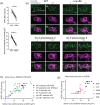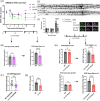Endoplasmic Reticulum Exit Sites scale with somato-dendritic size in neurons
- PMID: 37556208
- PMCID: PMC10559313
- DOI: 10.1091/mbc.E23-03-0090
Endoplasmic Reticulum Exit Sites scale with somato-dendritic size in neurons
Abstract
Nervous systems exhibit dramatic diversity in cell morphology and size. How neurons regulate their biosynthetic and secretory machinery to support such diversity is not well understood. Endoplasmic reticulum exit sites (ERESs) are essential for maintaining secretory flux, and are required for normal dendrite development, but how neurons of different size regulate secretory capacity remains unknown. In Caenorhabditis elegans, we find that the ERES number is strongly correlated with the size of a neuron's dendritic arbor. The elaborately branched sensory neuron, PVD, has especially high ERES numbers. Asymmetric cell division provides PVD with a large initial cell size critical for rapid establishment of PVD's high ERES number before neurite outgrowth, and these ERESs are maintained throughout development. Maintenance of ERES number requires the cell fate transcription factor MEC-3, C. elegans TOR (ceTOR/let-363), and nutrient availability, with mec-3 and ceTOR/let-363 mutant PVDs both displaying reductions in ERES number, soma size, and dendrite size. Notably, mec-3 mutant animals exhibit reduced expression of a ceTOR/let-363 reporter in PVD, and starvation reduces ERES number and somato-dendritic size in a manner genetically redundant with ceTOR/let-363 perturbation. Our data suggest that both asymmetric cell division and nutrient sensing pathways regulate secretory capacities to support elaborate dendritic arbors.
Figures







References
-
- Balklava Z, Pant S, Fares H, Grant BD (2007). Genome-wide analysis identifies a general requirement for polarity proteins in endocytic traffic. Nat Cell Biol 9, 1066–1073. - PubMed
-
- Barlowe C, Helenius A (2016). Cargo Capture and Bulk Flow in the Early Secretory Pathway. Annu Rev Cell Dev Biol 32, 197–222. - PubMed
Publication types
MeSH terms
Substances
Grants and funding
LinkOut - more resources
Full Text Sources
Research Materials

